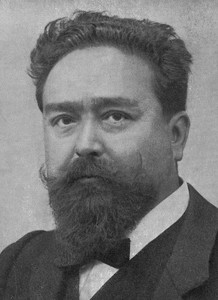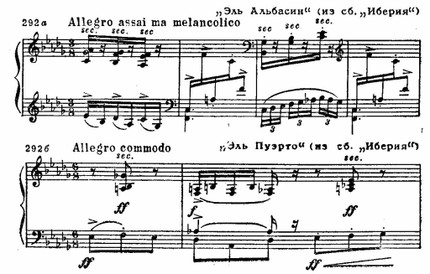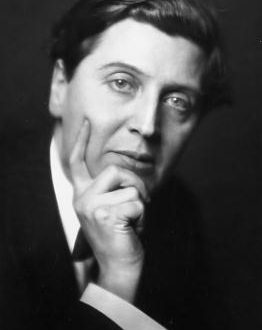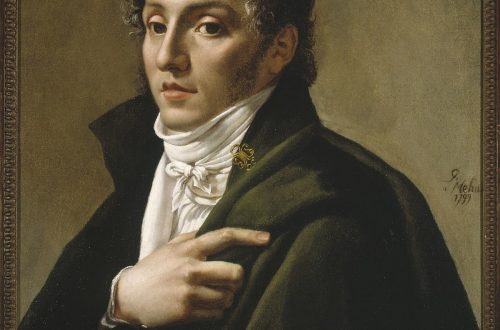
Isaac Albéniz |
Isaac Albéniz
The sublime and extraordinary musical intuition of Albeniz could be compared to a cup filled to the brim with pure wine, warmed by the Mediterranean sun. F. Pedrel

The name of I. Albeniz is inseparable from the new direction of Spanish music Renacimiento, which arose at the turn of the 10th-6th centuries. The inspirer of this movement was F. Pedrel, who advocated the revival of the Spanish national culture. Albéniz and E. Granados created the first classical examples of new Spanish music, and the work of M. de Falla became the pinnacle of this trend. Renacimiento embraced the entire artistic life of the country. It was attended by writers, poets, artists: R. Valle-Inklan, X. Jimenez, A. Machado, R. Pidal, M. Unamuno. Albéniz was born 1868 kilometers from the French border. Exceptional musical abilities allowed him to perform with his older sister Clementine in a public concert in Barcelona at the age of four. It was from his sister that the boy received the first information about music. At the age of XNUMX, Albeniz, accompanied by his mother, went to Paris, where he took piano lessons from Professor A. Marmontel. In XNUMX, the young musician’s first composition, “Military March” for piano, was published in Madrid.
In 1869, the family moved to Madrid, and the boy entered the conservatory in the class of M. Mendisabal. At the age of 10, Albeniz runs away from home in search of adventure. In Cadiz, he is arrested and sent to his parents, but Albeniz manages to get on a steamer bound for South America. In Buenos Aires, he leads a life full of hardships, until one of his countrymen organizes several concerts for him in Argentina, Uruguay and Brazil.
After traveling to Cuba and the USA, where Albeniz, in order not to die of hunger, works in the port, the young man arrives in Leipzig, where he studies at the conservatory in the class of S. Jadasson (composition) and in the class of K. Reinecke (piano). In the future, he improved at the Brussels Conservatory – one of the best in Europe, in piano with L. Brassin, and in composition with F. Gevaart.
A huge influence on Albeniz was his meeting with F. Liszt in Budapest, where the Spanish musician arrived. Liszt agreed to lead Albeniz, and this alone was a high assessment of his talent. In the 80s – early 90s. Albeniz leads an active and successful concert activity, tours in many countries of Europe (Germany, England, France) and America (Mexico, Cuba). His brilliant pianism attracts contemporaries with its brilliance and virtuoso scope. The Spanish press unanimously called him the “Spanish Rubinstein”. “Performing his own compositions, Albéniz was reminiscent of Rubinstein,” Pedrel wrote.
Beginning in 1894, the composer lived in Paris, where he improved his composition with such famous French composers as P. Dukas and V. d’Andy. He develops close contacts with C. Debussy, whose creative personality greatly influenced Albeniz, his music of recent years. In the last years of his life, Albéniz led the Renacimiento movement, realizing the aesthetic principles of Pedrel in his work. The best works of the composer are examples of a truly national and at the same time original style. Albeniz turns to popular song and dance genres (malagena, sevillana), recreating in music the characteristic features of various regions of Spain. His music is all saturated with folk vocal and speech intonations.
Of the great composer heritage of Albeniz (comic and lyric operas, zarzuela, works for orchestra, voices), piano music is of the greatest value. The appeal to Spanish musical folklore, these “gold deposits of folk art”, in the words of the composer, had a decisive influence on his creative development. In his compositions for piano, Albéniz makes extensive use of elements of folk music, combining them with modern techniques of composer writing. In the piano texture, you can often hear the sound of folk instruments – tambourine, bagpipes, especially guitars. Using the rhythms of the song and dance genres of Castile, Aragon, Basque Country and especially often Andalusia, Albeniz rarely confines himself to direct quotation of folk themes. His best compositions: “Spanish Suite”, suite “Spain” op. 165, cycle “Spanish tunes” op. 232, a cycle of 12 pieces “Iberia” (1905-07) – examples of professional music of a new direction, where the national basis is organically combined with the achievements of modern musical art.
V. Ilyeva
Isaac Albeniz lived stormily, unbalanced, with all the fervor of passion he devoted himself to his beloved work. His childhood and youth are like an exciting adventure novel. From the age of four, Albeniz began learning to play the piano. They tried to assign him to the Paris, then to the Madrid Conservatory. But at the age of nine, the boy runs away from home, performs in concerts. He is taken home and flees again, this time to South America. Albéniz was then twelve years old; he continued to perform. The following years pass unevenly: with varying degrees of success, Albeniz performed in the cities of America, England, Germany, and Spain. During his trips, he took lessons in composition theory (from Carl Reinecke, Solomon Jadasson in Leipzig, from Francois Gevaart in Brussels).
The meeting with Liszt in 1878 – Albeniz was then eighteen years old – was decisive for his future fate. For two years he accompanied Liszt everywhere, becoming his closest student.
Communication with Liszt had a huge impact on Albeniz, not only in terms of music, but more broadly – general cultural, moral. He reads a lot (his favorite writers are Turgenev and Zola), expanding his artistic horizons. Liszt, who so valued the manifestations of the national principle in music and therefore provided such generous moral support to Russian composers (from Glinka to The Mighty Handful), and Smetana, and Grieg, awakens the national nature of Albeniz’s talent. From now on, along with pianistic, he also devotes himself to composing.
After perfecting himself under Liszt, Albéniz became a pianist on a large scale. The heyday of his concert performances falls on the years 1880-1893. By this time, from Barcelona, where he had lived before, Albeniz moved to France. In 1893, Albeniz fell seriously ill, and later the illness confined him to bed. He died at the age of forty-nine.
The creative heritage of Albéniz is huge – it contains about five hundred compositions, of which about three hundred are for pianoforte; among the rest – operas, symphonic works, romances, etc. In terms of artistic value, his legacy is very uneven. This big, emotionally direct artist lacked a sense of self-control. He wrote easily and quickly, as if improvising, but he was not always able to highlight the essential, discard the superfluous, and succumbed to various influences.
So, in his early works – under the influence of castisismo – there is a lot of superficial, salon. These features were sometimes preserved in later writings. And here is another example: in the 90s, at the time of his creative maturity, experiencing severe financial difficulties, Albeniz agreed to write a number of operas commissioned by an English rich man who concocted a libretto for them; Naturally, these operas were unsuccessful. Finally, in the last fifteen years of his life, Albéniz was influenced by some French authors (above all, his friend, Paul Duc).
And yet in the best works of Albéniz – and there are many of them! – his national-original individuality is strongly felt. It was sharply identified in the very first creative searches of the young author – in the 80s, that is, even before the publication of Pedrel’s manifesto.
The best works of Albéniz are those that reflect the folk-national element of songs and dances, the color and landscape of Spain. These are, with the exception of a few orchestral works, piano pieces provided with the names of regions, provinces, cities and villages of the composer’s homeland. (Albéniz’s best zarzuela, Pepita Jiménez (1896), should also be mentioned. Pedrel (Celestina, 1905), and later de Falla (A Brief Life, 1913) wrote in this genus before him.). Such are the collections “Spanish tunes”, “Characteristic pieces”, “Spanish dances” or suites “Spain”, “Iberia” (the ancient name of Spain), “Catalonia”. Among the names of famous plays we meet: “Cordoba”, “Granada”, “Seville”, “Navarra”, “Malaga”, etc. Albeniz also gave his plays dance titles (“Seguidilla”, “Malaguena”, “Polo” and other).
The most complete and versatile in the work of Albeniz developed the Andalusian style of flamenco. The composer’s pieces embody the typical features of melody, rhythm, and harmony described above. A generous melodist, he gave his music features of sensual charm:

In melodics, oriental turns are often used:

Doubling the voices in a wide arrangement, Albeniz recreated the character of the sound of folk wind instruments:

He perfectly conveyed the originality of the guitar sound on the piano:


If we also note the poetic spirituality of the presentation and the lively narrative style (related to Schumann and Grieg), it becomes clear the great importance that should be assigned to Albeniz in the history of Spanish music.
M. Druskin
Short list of compositions:
Piano works Spanish tunes (5 pieces) “Spain” (6 “Album Sheets”) Spanish suite (8 pieces) Characteristic pieces (12 pieces) 6 Spanish dances First and Second ancient suites (10 pieces) “Iberia”, suite (12 pieces in four notebooks)
Orchestral works “Catalonia”, suite
Operas and zarzuelas “Magic Opal” (1893) “Saint Anthony” (1894) “Henry Clifford” (1895) “Pepita Jimenez” (1896) The King Arthur trilogy (Merlin, Lancelot, Ginevra, last unfinished) (1897-1906)
Songs and Romances (about 15)





